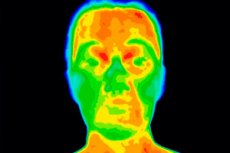Facial temperature may predict heart disease with greater accuracy than current methods
Sist anmeldt: 14.06.2024

Alt iLive-innhold blir gjennomgått med medisin eller faktisk kontrollert for å sikre så mye faktuell nøyaktighet som mulig.
Vi har strenge retningslinjer for innkjøp og kun kobling til anerkjente medieområder, akademiske forskningsinstitusjoner og, når det er mulig, medisinsk peer-evaluerte studier. Merk at tallene i parenteser ([1], [2], etc.) er klikkbare koblinger til disse studiene.
Hvis du føler at noe av innholdet vårt er unøyaktig, utdatert eller ellers tvilsomt, velg det og trykk Ctrl + Enter.

In a recent study published in BMJ Health & Care Informatics, researchers assessed the feasibility of using facial infrared thermography (IRT) to predict coronary artery disease (CHD).
IHD is one of the leading causes of death and has a significant global burden. An accurate diagnosis of CAD is important for care and treatment. Currently, pretest probability (PTP) assessment tools are used to determine the likelihood of CAD in patients. However, these tools have problems with subjectivity, limited versatility and moderate accuracy.
Although additional cardiovascular testing (coronary calcium count and electrocardiography) or sophisticated clinical models integrating additional laboratory markers and risk factors can improve probability estimates, there are concerns related to time efficiency, procedural complexity, and limited availability. p>
IRT, a non-contact surface temperature detection technology, is showing promise for disease assessment. It can detect inflammation and abnormal circulation through skin temperature patterns. Research shows associations between IRT information and atherosclerotic cardiovascular disease and related conditions.
In this study, researchers assessed the feasibility of using facial IRT temperature data to predict CAD. Adults undergoing coronary CT angiography (CCTA) or invasive coronary angiography (ICA) were included in the study. Trained personnel obtained the raw data and conducted the IRT survey before the CCTA or ICA.
Electronic medical records were used to obtain additional information, including blood chemistry, clinical history, risk factors, and CHD screening results. One IRT image per participant was selected for analysis and processed (unified resizing, grayscale conversion, and background cropping).
The team developed an IRT image model using an advanced deep learning algorithm. Two models were developed for comparison: one was a PTP (clinical baseline) model that included patients' age, gender, and symptom characteristics, and the other was a hybrid, combining both IRT information and clinical information from the IRT and PTP models, respectively.
Several interpretive analyzes were performed, including occlusion experiments, excretion map visualization, dose-response analyses, and CAD surrogate label prediction. In addition, various tabular IRT features were extracted from the IRT image, classified at the level of the whole face and region of interest (ROI).
Overall, the extracted features were classified into first-order texture, second-order texture, temperature, and fractal analysis features. The XGBoost algorithm integrated these extracted features and assessed their predictive value for CAD. The researchers evaluated performance using all characteristics and only temperature characteristics.
A total of 893 adults undergoing CCTA or ICA were assessed between September 2021 and February 2023. Of these, 460 participants with a mean age of 58.4 years were included; 27.4% were women, and 70% had CAD. Patients with CAD had a higher age and prevalence of risk factors compared with patients without CAD. The IRT image model significantly outperformed the PTP model.
However, the performance of the hybrid and IRT imaging models was not significantly different. Using only temperature features or all extracted features had superior predictive performance, which was consistent with the IRT imaging model. At the level of the entire face, the greatest influence was the overall temperature difference from left to right, while at the ROI level, the average temperature of the left jaw had the greatest influence.
Various levels of performance degradation were observed for the IRT image model when different ROIs were occluded. Occlusion of the upper and lower lip areas had the greatest impact. In addition, the IRT imaging model performed well in predicting surrogate markers associated with CAD, such as hyperlipidemia, smoking, body mass index, glycated hemoglobin, and inflammation.
The study demonstrated the feasibility of using facial IRT temperature data to predict CAD. The IRT imaging model outperformed the guideline-recommended PTP model, highlighting its potential in the assessment of CAD. Additionally, incorporating clinical information into the IRT image model did not provide additional improvements, suggesting that the extracted IRT information already contained important CAD-related information.
Furthermore, the predictive value of the IRT model was confirmed using interpretable tabular IRT features that were relatively consistent with the IRT image model. These characteristics also provided information on important aspects for predicting CAD, such as facial temperature symmetry and uneven distribution. Further studies with larger samples and diverse populations are needed for validation.
